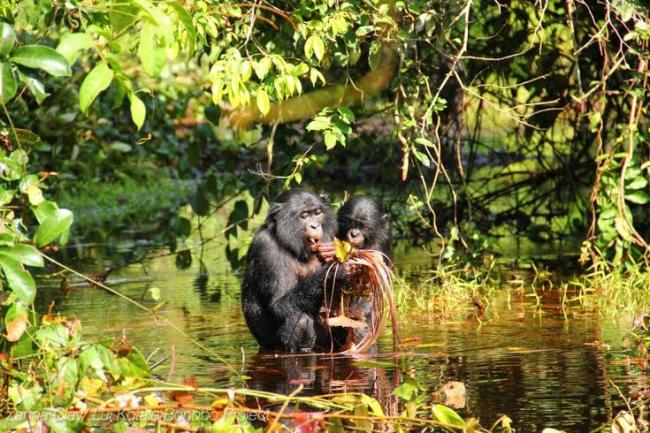06 Aug 2015, 06:49 am

The finding that bonobos use a type of call, that alters meaning depending on context, echoes the context independent manner in which human babies can also communicate.
Bonobos make ‘peep’ calls which are short, very high-pitched and produced with a closed mouth. They produce these calls in a wide range of situations, across positive, negative and neutral circumstances.
The researchers looked at the acoustic structure and found that the peep calls did not vary acoustically between neutral and positive contexts – for example, between feeding, travelling and resting.
It is this similarity in calls made across different emotional contexts that echo the similarities found in human infant vocalisations.
Zanna Clay, from the University of Birmingham’s School of Psychology, who led the study, said: ‘When I studied the bonobos in their native setting in Congo, I was struck by how frequent their peeps were, and how many different contexts they produce them in. It became apparent that because we couldn’t always differentiate between peeps, we needed to understand the context to get to the root of their communication.’
The common assumption is that primate calls are tightly tied to certain contexts and emotional states, whereas many human vocalisations are freed from this.
However, before language develops, human babies can produce a group of calls – called 'protophones' – independently of their emotional state. These types of infant calls differ from commonly recognised calls such as laughter and crying, and the calls of most animals, which are thought only to be produced in certain contexts.
Clay added: ‘We felt that it was premature to conclude that this ability is uniquely human, especially as no one had really looked for it in the great apes. It appears that the more we look the more similarity we find between animals and humans.’
The type of communication the researchers observed in the wild bonobos could represent an important evolutionary transition from ‘functionally fixed animal vocalisations’ – vocalisations that are tied to specific contexts or emotional states – towards human vocalisations, which seems to have appeared some 6 – 10 million years ago with the bonobo, our shared common ancestor with apes.
The research, published in the journal PeerJ, also found that the peeps made in emotionally negative circumstances, such as an aggressive encounter, or in response to predators, demonstrate a pattern more typical to primates in that the acoustic structure is more closely tied to certain emotional states.
- This City is Quietly Redefining What a Holiday Experience Looks Like
- Saigon Sisters in Chicago — A Dumplings & Bao Love Story
- Beyond Old and New: Bickram Ghosh and the Art of Fusion at Serendipity
- From Kennedy’s Proposal to 1850s Saloons: The Three Historic D.C. Restaurants Everyone Must Try
- This city has the best bagel in the US, and it’s not New York!
- I escaped to Pachmarhi — what I found in the queen of Satpura left me spellbound
- Air Canada just ranked the Best New Restaurants of 2025 - And the Top Spot isn't who you think
- Rediscovering Arunachal's Monpa Cuisine: One Woman’s Millet Momo Revolution
- Discovering Heritage: A visual journey through Odisha crafts museum Kalabhoomi
- From kebabs to biriyani: Lucknow gets UNESCO honour for its royal cuisine
Etihad Airways is set to introduce direct flights to Luxembourg, becoming the first airline from the Middle East to operate services to the country. Launching on Oct 29 2026, the new route will also be the only nonstop connection between Luxembourg and Abu Dhabi, linking two key centres in Europe and the Middle East, the airline said.
Lufthansa will mark its 100th anniversary in 2026, commemorating a century since the founding of the original “Luft Hansa” on January 6, 1926. The airline’s first flight followed shortly after, on April 6 of the same year, marking the beginning of what would become one of aviation’s most recognisable brands.
Tata Group-owned Air India on Tuesday announced a new, unilateral codeshare partnership with airBaltic, the flag carrier of Latvia, thus making the Baltic region more conveniently accessible for Air India customers.





